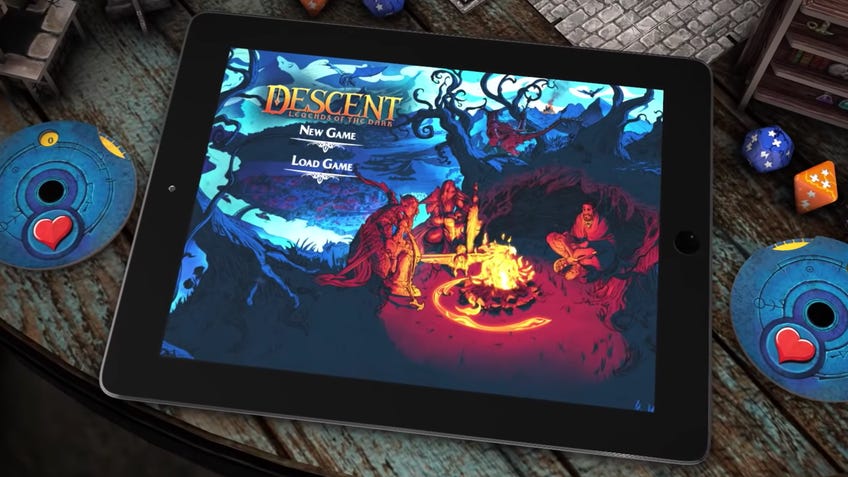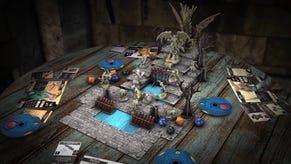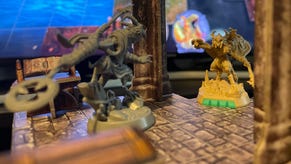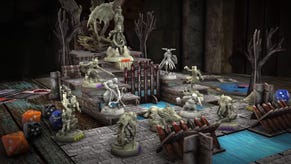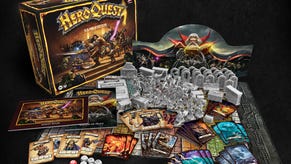Descent: Legends of the Dark’s impressive digital companion sets a new bar for app-powered board games
Digital love.
Descent: Legends of the Dark is a bold - and controversial - new direction for the beloved dungeon-crawler series. Like Mansions of Madness before it, Legends of the Dark does away with predecessor Descent: Journeys in the Dark’s GM-like overlord player, putting all of its human players on the same team as they battle against the digital villainy of the game’s now mandatory companion app.
While Journeys in the Dark did eventually receive a companion app in the form of the optional Roads to Legend, which effectively provided an automated overlord for groups wanting to play in full co-op, Legends of the Dark (which is very much not a third edition of Journeys, according to its designers) has clearly been built with a companion app at its centre.
The game’s scenarios - played out in eye-catching 3D environments thanks to cardboard terrain, with players moving figures between spaces and chucking dice to resolve combat and tests - are punctuated by interactions with the app. Players drag their heroes’ portraits around the screen to initiate combat with enemies, plugging their dice results in so the app can calculate damage, status effects and other behaviour. Between each mission, players’ characters take a breather in the city of Frostgate, using the app to resolve smaller narrative events, upgrade their weapons and craft items to take into later adventures.
The decision to make digital gameplay such a key part of Legends of the Dark has sparked predictable backlash from board game fans who feel that digital experiences should be kept separate from their cardboard cousins. Do apps help lift heavy rules for players, or detract from the tangible nature of tabletop games by staring at a screen? That's a debate that will continue to burn for some time to come. That aside, based on my time with Legends of the Dark’s pre-release preview app so far (a full review will be coming once I’ve finished the campaign; I’ve played a handful of scenarios/half-dozen hours so far), I think it makes a very impressive case for what a companion app can bring to a board game.
Where Mansions walked and Journeys in Middle-earth ran, Legends of the Dark flies high.
Some upfront context: I’m generally on the side of companion apps in board games, at least when they’re used well. Not every board game needs an app, but some benefit from streamlining rules and providing a more immersive experience for players by quietly handling more complex branching stories or randomised events. There’s a balance to be found between keeping what you’re doing on the tabletop meaningful and the convenience afforded by a digital companion - nobody wants to play a video game with an awkward physical gimmick attached - but the right combination can enhance a tabletop experience. Mansions of Madness’ tales of horror feel more mysterious and unsettling when all of the players can’t predict what’s coming, while Detective’s online police database puts you right in an episode of CSI as you browse evidence and files.

Descent: Legends of the Dark is clearly built on the solid foundations of Mansions of Madness’ companion app, which took an evolutionary step in Lord of the Ring: Journeys in Middle-earth’s more ambitious connected campaign, providing RPG-lite character levelling, persistent narrative decisions and enemies with unique effects and abilities.
Legends of the Dark is like playing a fantasy dungeon-crawler for a couple of hours, only to take a five-minute break with a visual novel.
Where Mansions walked and Journeys in Middle-earth ran, Legends of the Dark flies high. The gameplay basics will be familiar to fans of those previous games - players move their figures on the board, before interacting in the app with objects and enemies - and there are a number of new gameplay elements on the table itself, including the engaging card-flipping ‘ready’ mechanic and the spectacular 3D terrain, but it’s in its companion app that Legends of the Dark really finds its magic.
On a purely visual level, Legends of the Dark is the best-looking companion app I’ve seen for a board game. The board game’s revamped artwork - adopting a slightly more comic-book style - pops in dedicated cutscenes between the players’ heroes and inhabitants of the world, making the narrative interludes between the hack-and-slash scenarios feel more alive and interesting as a result. In some ways, playing Legends of the Dark is like playing a fantasy dungeon-crawler for a couple of hours, only to take a five-minute break with a visual novel. That's not a bad thing.
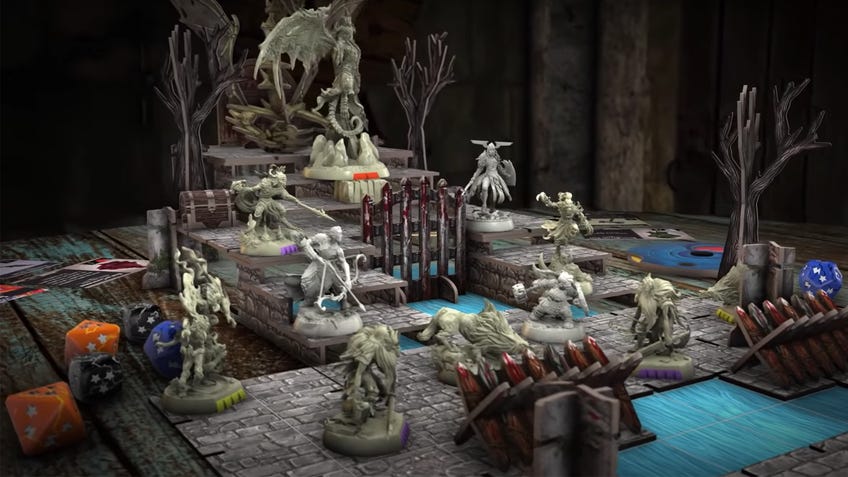
Combined with effective writing - albeit steeped in various fantasy tropes - and the ability for players to choose between decisions that feel genuinely meaningful, and appear to have real impact on the world and characters, the app helps provide a properly fleshed-out story to enjoy over the game’s many hours. After being left cold by previous games in the fantasy setting, I didn’t expect to ever care about Descent’s world of Terrinoth, but Legends of the Dark’s rock-solid storytelling has me playing to find out what happens to this ragtag band of heroes.
Having characters react in different ways to the world - and the world to them - is one of the app’s strongest points.
It’s not only Legends of the Dark’s broader narrative strokes that work well, either. A small but vital change in the companion app is the ability to select which character is interacting with a specific token or enemy, rather than the generalised “someone does this” approach of Mansions. Dragging a hero’s picture to an enemy or object in the world often produces unique dialogue and narration based on that character’s nature, as well as (as far as I can tell) sparking the chance for an enemy to seek reprisal against their last attacker depending on their own behaviour. Having characters react in different ways to the world - and the world to them - without requiring players to rifle through a card deck or physical tome, or the GM to track every individual interaction, is one of the app’s strongest points. The app complements the extravagant - but welcome - terrain and miniatures in absorbing players into its world. Most importantly, it manages that without invalidating the point of rolling dice, flipping cards and moving miniatures, serving as an effective backdrop for the action on the table.
It feels odd to describe a $175 board game with a cubic box the size of a foot stool as “surprisingly modest”, but here I am. Let me be clear: Legends of the Dark’s contents don’t skimp on pure quantity - there are dozens of miniatures (a significant step up from Mansions’ bendy monsters), and so much 3D cardboard terrain the whole bottom half of the two-tier box arrives as empty storage. What has struck me about Legends of the Dark as I journey through its campaign is how far the app cleverly stretches what’s in the box, to make it feel like a game of twice the size.
There’s the way that enemies can appear as different variants, represented by the same miniature but distinguished in the app by different descriptors and colourblind-friendly markers attached to their model. A regular bandit might shoot at you from a few squares away, but a bandit sniper may suddenly pose a longer-distance threat, vanishing into a smoke cloud after each attack. The cardboard terrain on the board is also used to its full potential, popping up a number of possible interactions in each scenario - you might be climbing a tree to solve a puzzle in one scenario, only to forage for crafting materials or eat fruit to heal up during battle the next. Mini-bosses can be souped-up versions of regular baddies, saving on the plastic needed to sculpt a figure you only use once. In the age of Kickstarter boxes crammed with unnecessary miniatures, it’s a strange relief to praise this pricey package as being oddly restrained, helped by the open freedom of its app to remix and refresh its physical ingredients in new combinations.

Legends of the Dark’s app helps get the most out of its physical components, but the app has plenty of its own substance to add to the mix, too. As well as giving the players the chance to embark on the game’s main quests and side scenarios that pop up during their adventures, the app handles the bulk of the satisfying weapon customisation system. Players can use recipes and materials collected during scenarios to craft new parts of their equipment - a hilt for a sword, claws on a gauntlet or a wrap for a wand, for example - that then grant bonus effects and abilities in future missions. While some crafted items - such as consumables - are represented by physical cards, weapon parts are kept in the app, neatly represented by an icon that shows their digital-only effect, from a 20% chance to deal extra damage or heal a character to inflicting various status effects. The myriad abilities and randomisation would be a headache for a GM for handle - not to mention eating up precious minutes of game time with admin - but for the app it’s just another calculation to quietly take care of behind the flashy visuals and slick UI.
A number of hours into Legends of the Dark’s campaign, I feel like I’ve only just scratched the surface of what its companion app can do.
Even a number of hours into Legends of the Dark’s campaign, I feel like I’ve only just scratched the surface of what its companion app can do. It keeps springing up new surprises, both in the game’s world and the app itself. Our latest scenario ended in failure and marked a terrible, tragic turn of events for a character. Rather than throwing us back to the beginning of the scenario to try again, the app simply accounted for the impact of the events on our party and their companions, leading to a series of smaller events that acknowledged the loss - and hinted at a far-reaching consequence on the main story.
I’m excited to continue delving into Descent’s story and to see how its app brings its world and characters to life. Its place right at the heart of the board game won’t suddenly convert companion app non-believers in the idea of harmony between cardboard and digital. For those like me who are already willing to let those worlds collide, however, it sets a new standard for app-powered board games - one that has completely hooked on seeing everything Legends of the Dark has to offer.
Descent: Legends of the Dark will be released on August 6th. This article was based on pre-release access to a preview app on Windows PC.
